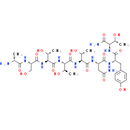Description
DAPTA is a potent and selective CCR5 antagonist
Product information
CAS Number: 106362-34-9
Molecular Weight: 856.88
Formula: C35H56N10O15
Synonym:
D-Ala-peptide T-amide
Adaptavir
Chemical Name: L-Threoninamide, D-alanyl-L-seryl-L-threonyl-L-threonyl-L-threonyl-L-asparaginyl-L-tyrosyl-
Smiles: C[C@@H](N)C(=O)N[C@@H](CO)C(=O)N[C@@H]([C@@H](C)O)C(=O)N[C@@H]([C@@H](C)O)C(=O)N[C@@H]([C@@H](C)O)C(=O)N[C@@H](CC(N)=O)C(=O)N[C@@H](CC1=CC=C(O)C=C1)C(=O)N[C@@H]([C@@H](C)O)C(N)=O
InChiKey: AKWRNBWMGFUAMF-ZESMOPTKSA-N
InChi: InChI=1S/C35H56N10O15/c1-13(36)29(54)41-22(12-46)32(57)43-26(16(4)49)34(59)45-27(17(5)50)35(60)44-25(15(3)48)33(58)40-21(11-23(37)52)30(55)39-20(10-18-6-8-19(51)9-7-18)31(56)42-24(14(2)47)28(38)53/h6-9,13-17,20-22,24-27,46-51H,10-12,36H2,1-5H3,(H2,37,52)(H2,38,53)(H,39,55)(H,40,58)(H,41,54)(H,42,56)(H,43,57)(H,44,60)(H,45,59)/t13-,14-,15-,16-,17-,20+,21+,22+,24+,25+,26+,27+/m1/s1
Technical Data
Appearance: Solid Power
Purity: ≥98% (or refer to the Certificate of Analysis)
Solubility: H2O : 50 mg/mL (58.35 mM; Need ultrasonic)
Shipping Condition: Shipped under ambient temperature as non-hazardous chemical or refer to Certificate of Analysis
Storage Condition: Dry, dark and -20 oC for 1 year or refer to the Certificate of Analysis.
Shelf Life: ≥12 months if stored properly.
Stock Solution Storage: 0 - 4 oC for 1 month or refer to the Certificate of Analysis.
Drug Formulation: To be determined
HS Tariff Code: 382200
How to use
In Vitro:
DAPTA is a non-toxic experimental antiviral entry inhibitor. DAPTA potently inhibits specific CD4-dependent binding of gp120 Bal (IC50 = 0.06 nM) and CM235 (IC50 = 0.32 nM) to CCR5. In co-immunoprecipitation studies, DAPTA (1 nM) blocks formation of the gp120/sCD4 complex with CCR5. Confocal microscopic studies of direct FITC-DAPTA binding to CCR5+, but not CCR5−, cells show that CCR5 is a DAPTA receptor. DAPTA is an antagonist of CCR5-mediated chemotaxis and is most effective as an antiviral agent primarily against R5-tropic HIV-1 isolates, with reduced or absent effect for X4-tropic laboratory isolates. DAPTA does not inhibit fusion in typical assays, which use high local concentrations of virus and cells[1]. The Th2 cytokines IL-4, IL-10, and IL-13, are increased by DAPTA and induce a potent virostatic state in infected macrophages in vitro, as well as inhibit production of the proinflammatory cytokines IL-1 and TNFα, which upregulate virus expression. Thus the elevation of Th2 cytokines by DAPTA treatment would favor less macrophage viral replication[2].
In Vivo:
The levels of inflammatory cytokines IL-1, IL-6, and TNFα decrease in plasma following DAPTA treatment[2]. Peptide T(DAPTA) treatment prevents the neuronal cell death associated with gpl20. DAPTA prevents gpl20-associated neural deficits in vivo[3].
References:
- Polianova MT, et al. Antiviral Res. 2005, 67(2):83-92.
- Ruff MR, et al. Curr HIV Res. 2003, 1(1):51-67.
- Hill JM, et al. Brain Res. 1993, 603(2):222-33.
- Ruff MR, et al. Antiviral Res. 2001, 52(1):63-75.
Products are for research use only. Not for human use.
Payment & Security
Your payment information is processed securely. We do not store credit card details nor have access to your credit card information.


